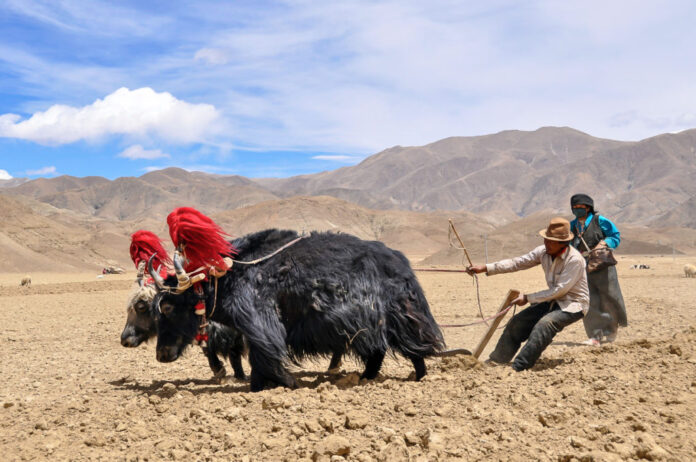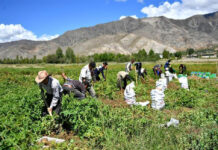(TibetanReview.net, Dec16’20) – More than 604,000 farmers and herdsmen in Chinese-ruled Tibet Autonomous Region (TAR) had been helped to find jobs this year, reported China’s official Xinhua news agency Dec 16, citing local authorities. A recent independent research was reported to have found that China had subjected more than 500,000 Tibetans in the region to military style job-training regimes for placement in factories across the People’s Republic of China at exploitative wages.
The report said the jobs had generated an income of more than 4.5 billion yuan (about 688 million US dollars), citing according to the regional department of human resources and social security. This, if true, means a per capital income of 7,450 yuan ($1,139).
The report also said the TAR had around 2.4 million farmers and herdsmen, accounting for nearly 68 per cent of its entire population, with some living in high altitude and remote areas.
In his report, Tibet and Xinjiang researcher Adrian Zenz had said in The Jamestown Foundation that China had introduced new policies to promote a centralised and large-scale transfer of ‘rural surplus labourers’ to parts of the TAR, as well as other provinces of the People’s Republic of China in repeated attempts to change the demography of the region.
He said the policy mandates that the pastoralists and farmers were to be subjected to centralised “military-style” vocational training, which aimed to reform “backward thinking”, while also including training in the Chinese language, and training in “work discipline.”
The draconian system of the policy was reported to show a disturbing number of similarities to the system of coercive vocational training and labour transfer suffered by Uyghur Muslims in Xinjiang, an ethnic Muslim religion which is also under repressive Chinese occupation rule.
The report noted that in the TAR’s Chamdo region, militarised training regimen was being supervised by the paramilitary Chinese Armed Police drill sergeants, while training photos depicted Tibetan trainees dressed in military fatigues.
The recruitments of such trainees were said to involve village-based work teams and a social control mechanism used in Xinjiang to identify Uyghurs to be sent to internment camps.
Key policy documents were also reported warn that cadres who fail to achieve mandated quotas were to be subjected to “strict punishments.”
From 2012, the Chamdo region initiated a ‘military-style training for surplus labour force transfer for pastoral and agricultural regions’, and by 2016, the region had established 45 related vocational training bases, noted an ANI report Dec 15.
This scheme has numerous similarities to Xinjiang’s training practices, such as a high-powered focus on mobilising a ‘reticent’ minority group to change their traditional livelihood mode and employ military-style management to produce discipline and obedience, The Jamestown Foundation report was further cited as saying.
The report said that in the first seven months of this year, the TAR had trained 543,000 rural surplus labourers, out of which 49,900 were transferred to other parts of the region and 3,109 to other parts of the PRC.
The report was cited as saying there were clear elements of coercion during the trainees’ recruitment, training and job matching, as documents described poverty alleviation as a ‘battlefield’, with huge pressure on local governments to round up poor populations and feed them into the scheme.




